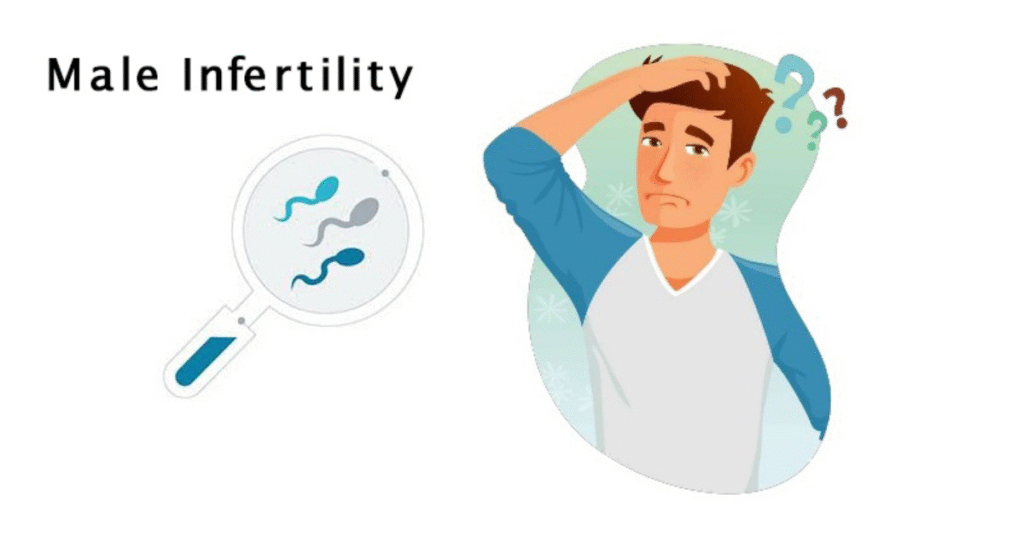
Understanding Male Infertility: Causes, Diagnosis & Treatment Options
Introduction
Infertility is a journey many couples face silently. While much attention is often given to female fertility, male infertility is an equally critical piece of the puzzle — affecting up to 50% of couples struggling to conceive when a male factor is involved. Understanding male infertility — its causes, diagnosis, and treatment options — is vital for men and couples seeking clarity, hope, and solutions.
In this comprehensive guide, you will learn:
- What is male infertility
- Key terms and types (e.g. azoospermia, oligospermia, asthenozoospermia, teratozoospermia)
- Causes and risk factors (genetic, hormonal, lifestyle, environmental)
- Symptoms and signs
- Diagnostic workup / male fertility tests
- Treatment and management (medical, surgical, assisted reproduction)
- Lifestyle & natural strategies to improve male fertility
- Emotional, psychological, and partner aspects
- Frequently asked questions (FAQs)
- When to see a specialist
1. What is Male Infertility?
Definition
Male infertility refers to a man’s inability to cause pregnancy in a fertile female partner. Technically, if a couple has tried to conceive regularly for 12 months (or 6 months in women older than 35) without success, evaluation is generally recommended — including assessment of the male partner.
Although some men show no obvious symptoms, the root problem often lies in sperm production, sperm function, or blockage of sperm transport.
Statistics suggest that male factor contributes to ~30–50% of infertility cases globally.
Over recent decades, researchers have documented a decline in sperm counts globally, making male infertility an increasing public health concern.
2. Key Terms & Types of Sperm Abnormalities
When discussing male infertility, certain technical terms frequently arise. Here’s a primer on the most common:
- Oligospermia: Low sperm count (fewer sperm per milliliter of semen)
- Azoospermia: Absence of sperm in the ejaculate — there’s no detectable sperm.
- Asthenozoospermia / Asthenospermia: Poor sperm motility (reduced movement).
- Teratozoospermia / Teratospermia: High percentage of abnormally shaped sperm (morphology defects).
- Azoospermia subtypes
• Obstructive azoospermia (sperm are produced but blocked in transport)
• Non-obstructive azoospermia (sperm production failure in testicles) - Unexplained male infertility (idiopathic infertility): When all tests are essentially normal, yet conception has not happened (this remains in 30–70% of cases)
3. Causes & Risk Factors of Male Infertility
Male infertility is often multifactorial. In many men, multiple causes may work together. The main categories are:
A. Genetic & Chromosomal Factors
- Klinefelter syndrome, Y-chromosome microdeletions, chromosomal abnormalities, single-gene mutations — these factors affect sperm production, testicular function, and syndromic issues.
- Up to ~4% of infertile men have a known genetic diagnosis.
- Many more cases remain idiopathic, i.e. unknown cause.
B. Hormonal & Endocrine Causes
- Problems in the hypothalamus-pituitary-gonadal axis (e.g. low FSH, LH, testosterone)
- Disorders such as hypogonadism or endocrine disruptors
- Use of anabolic steroids or exogenous testosterone suppresses sperm production
C. Structural / Anatomical Causes
- Varicocele (enlarged veins in the scrotum) is a common correctable cause
- Obstruction of vas deferens or ejaculatory ducts (from infection, injury, congenital absence)
- Previous surgeries, trauma to the testicles, hernia repairs
D. Infections / Inflammation
- Sexually transmitted infections, prostatitis, epididymitis, orchitis
- Scarring or blockage of ducts
- Immune/inflammatory factors including antisperm antibodies (ASA) in ~10–30% of infertile couples, and ~12–13% among male infertility cases.
E. Lifestyle, Environmental, & Behavioral Factors
- Smoking, alcohol use, illicit drugs, obesity, poor diet, stress
- Heat exposure (tight underwear, hot baths, saunas, laptop on lap)
- Occupational exposures: heavy metals, solvents, radiation, pesticides
- Excessive cycling or intense training
- Electromagnetic radiation / mobile phone use (less conclusive evidence)
F. Age and General Health
- While male fertility declines more gradually with age than female fertility, advancing paternal age associates with higher rates of DNA fragmentation, genetic risk, and lower semen quality
- Comorbidities such as diabetes, hypertension, obesity can impair reproductive health
G. Idiopathic / Unknown
- In a large proportion (30–70%) of cases, no clear cause is found, labelled “unexplained” or “idiopathic” infertility
4. Signs & Symptoms — What to Watch For
Men with infertility may have no overt symptoms, which is why tests are crucial. However, signs which may suggest an underlying problem include:
- Difficulties with sexual function (erectile dysfunction, low libido)
- Small, soft, or painful testicles
- Swelling in the scrotum or varicocele
- Prior history of testicular injury, infection, mumps orchitis, cryptorchidism
- Hormonal symptoms: fatigue, loss of muscle mass, changes in secondary sexual features
- Genetic features (e.g. small stature, gynecomastia)
But again — many men feel entirely normal; so absence of symptoms does not exclude fertility issues.
5. Diagnostic Workup & Male Fertility Tests
When consulting a urologist or andrologist, the diagnostic pathway typically involves:
A. Medical & Reproductive History
- Duration and pattern of infertility
- Past medical history: surgeries, injuries, infections, testicular history
- Medications, hormonal, anabolic steroid use
- Lifestyle, occupational exposures
- Sexual history, erectile or ejaculatory problems
B. Physical Examination
- Assessment of penile and testicular anatomy
- Palpation for varicocele
- Checking vas deferens presence
- Secondary sexual characteristics
C. Semen Analysis (Semen Test)
This is often the first-line test. Key parameters:
- Sperm concentration / count
- Motility / progressive motility
- Morphology / normal forms
- Volume, pH, liquefaction
- Vitality, white cells / infection
- Repeat analysis is recommended (2–3 specimens)
Abnormal results lead to further evaluation.
D. Hormonal Tests
- FSH, LH, testosterone, prolactin, TSH
- Sometimes estradiol, inhibin B, anti-Müllerian hormone
E. Genetic Tests
- Karyotype, Y-chromosome microdeletion testing, CFTR mutation (especially in absence of vas deferens)
F. Imaging / Specialized Tests
- Scrotal ultrasound (testes, varicocele)
- Transrectal ultrasound (TRUS) to assess ejaculatory ducts
- Doppler studies
- Testicular biopsy (in selected cases)
- DNA fragmentation tests, sperm function assays (less routinely used)
A comprehensive guideline by the Urological Society of India offers structured algorithms and recommendations for male infertility workup.
6. Treatment & Management Options
Treatment depends on the underlying cause, semen parameters, partner factors, age, and couple preferences. Here’s a breakdown of common approaches:
A. Medical Treatments & Supplements
- Hormonal therapy (e.g. gonadotropins, anti-estrogens) when endocrine causes present
- Empiric use of antioxidants (e.g. vitamins C, E, CoQ10, selenium, L-carnitine) — evidence varies
- Addressing infections or inflammation (antibiotics)
- Discontinuing harmful drugs, improving overall health
B. Surgical / Interventional Treatments
- Varicocelectomy (microsurgical repair of varicocele) — may improve sperm quality in selected men
- Surgical correction of obstructive lesions or ejaculatory duct obstruction.
- Sperm retrieval surgeries (e.g. testicular sperm extraction, TESE) in non-obstructive azoospermia, or micro-TESE
C. Assisted Reproductive Techniques (ART)
- Intrauterine insemination (IUI) — used in mild to moderate male factor
- In vitro fertilization (IVF) & intracytoplasmic sperm injection (ICSI) — injection of a single sperm into an egg
- Use of surgically retrieved sperm for ART when no sperm in ejaculate
These techniques allow many couples to conceive despite severe male factor issues.
D. Genetic Counseling & Assisted Decision Making
When a genetic cause is identified, counseling about recurrence risks and prenatal choices is important.
7. Lifestyle & Natural Strategies to Boost Male Fertility
While medical and surgical treatments address underlying pathology, lifestyle optimization can enhance outcomes:
- Quit smoking, reduce alcohol, avoid illicit drug use
- Maintain healthy weight and exercise moderately
- Balanced diet rich in antioxidants, omega-3 fatty acids, vitamins, minerals
- Avoid excessive heat (tight underwear, hot tubs, laptops on lap)
- Limit exposure to toxins (pesticides, solvents) and electromagnetic radiation
- Manage stress, ensure adequate sleep
- Frequent but not excessive ejaculation may help reduce DNA damage
- Reduce use of harmful medications under supervision
Behavior changes sometimes show measurable improvement in semen quality.
8. Psychological & Relationship Considerations
Infertility can bring emotional stress, guilt, stigma, and strain on relationships. It’s vital to:
- Encourage open communication between partners
- Seek counseling or support groups
- Address mental health (depression, anxiety)
- Recognize that infertility is a shared journey, not just a male or female issue
A holistic approach combining medical, psychological, and couple-based care yields the best outcomes.
9. Frequently Asked Questions (FAQs)
Q: Can male infertility be reversed?
A: In many cases yes — especially when treatable causes (varicocele, infection, hormonal imbalance, obstruction) are addressed. In more severe or idiopathic cases, assisted reproduction offers pathways to fatherhood.
Q: How long does it take to see improvement?
A: Spermatogenesis takes ~ 72–90 days. So any intervention (lifestyle change, medical therapy) may require 3–6 months or more before changes in semen appear.
Q: Does age matter in men?
A: Yes — though more gradual than in women, advancing paternal age is linked to increased DNA damage, mutations, and reduced fertility.
Q: Should both partners be tested?
A: Definitely. In most couples, both male and female evaluations proceed in parallel to avoid delays.
Q: Are antioxidant supplements safe?
A: Many are considered low-risk, but always consult a specialist before initiating, especially in context of fertility treatment.
Q: When should I see a specialist?
A: If after 6–12 months of trying pregnancy you have no success, or any known risk factors (e.g. history of mumps, varicocele, testicular surgery, low sperm count) exist.
10. When to Consult a Specialist / Next Steps
- After 6 months (if female partner > 35) or 12 months (for general) of unprotected, regular intercourse
- If semen analysis is abnormal
- If there is a history of testicular injury, surgery, cryptorchidism, infections
- If hormonal or genetic abnormalities are suspected
An andrologist or reproductive urologist can guide further testing, interpretation, and a personalized management plan.
Conclusion
Male infertility is a complex, multi-dimensional issue that calls for clarity, empathy, and evidence-based care. Through careful evaluation, targeted treatment, lifestyle optimization, and psychological support, many men and couples can find a path toward achieving pregnancy. Knowledge is power — and understanding the causes, tests, and options is the first big step.
If you or someone you know is navigating male infertility, feel free to ask more specific questions (e.g. on varicocele, ICSI, supplements, or genetic testing). You’re not alone — there are resources, specialists, and hope.
References
- Mayo Clinic: Male infertility — symptoms and causes
- Cleveland Clinic: Male infertility — causes, diagnosis, and treatment
- StatPearls / NCBI: Semen Analysis & Male Infertility overview
- Lifestyle causes of male infertility review
- Urological Society of India guidelines for male infertility
- Temporal trends in sperm count (global decline)
- Genetic causes, chromosomal abnormalities, idiopathic infertility reviews
- Antisperm antibodies and immune infertility
- Oligospermia & assisted reproduction options



